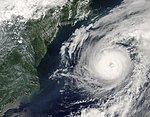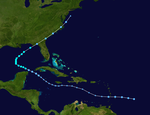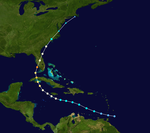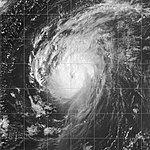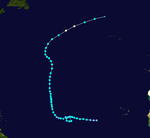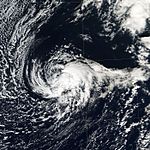2004 Atlantic hurricane season

| |
| First storm started: | July 31, 2004 |
| Last storm ended: | December 3, 2004 |
| Strongest storm: | Hurricane Ivan - 910 mbar, 180 mph winds |
| Number of storms: | 15 named storms |
| Major hurricanes (Cat. 3+) | 6 |
| Cost of damage: | $42 billion (2004 USD) $44.9 billion (2006 USD) |
| People killed: | 3,132+ |
The 2004 Atlantic hurricane season officially began on June 1, 2004. It lasted until November 30. These dates usually mark the beginning an the end of the period of each year when most tropical cyclones form in the Atlantic basin. However, the 2004 season went past these actual limits slightly. For example, Tropical Storm Otto formed on the last day of the season and lasted two days into December. The season was above average in activity. It had fifteen named storms and one of the highest Accumulated Cyclone Energy totals ever recorded. The most season included storms called: Hurricane Charley, Frances, Ivan, and Jeanne.[1]
Storms
[change | change source]Hurricane Alex
[change | change source]| Category 3 hurricane | |
| Duration | July 31 – August 6 |
|---|---|
| Peak intensity | 120 mph (195 km/h) (1-min) 957 mbar (hPa) |
Hurricane Alex formed on July 31 off the coast of South Carolina. Alex quickly strengthened into a category 2. On August 3, Hurricane Alex came within 10 miles of North Carolina. Hurricane Alex turned northeast and dissipated in the middle of the Atlantic Ocean. Because Hurricane Alex did not make landfall it only caused $2.4 million in damage and only 1 person was killed as a result of the hurricane.[2]
- For the official forecasts, see the NHC's archive on Hurricane Alex.
Tropical Storm Bonnie
[change | change source]| Tropical storm | |
| Duration | August 3 – August 13 |
|---|---|
| Peak intensity | 65 mph (100 km/h) (1-min) 1001 mbar (hPa) |
Bonnie started as Tropical Depression Two while east of Barbados. Tropical Depression Two crossed the Windward Islands and died out shortly after. It became Tropical Depression Two again while it was south of Cuba. Tropical Storm Bonnie made landfall in the Florida Panhandle. Bonnie died out again after that. Bonnie left only about $1 million in damage and 4 deaths. For the official forecasts, see:
- the NHC's archive on Tropical Storm Bonnie.
- the HPC's advisory archive on Bonnie after landfall Archived 2004-08-19 at the Wayback Machine.
Hurricane Charley
[change | change source]| Category 4 hurricane | |
| Duration | August 9 – August 14 |
|---|---|
| Peak intensity | 150 mph (240 km/h) (1-min) 941 mbar (hPa) |
Hurricane Charley was a strong hurricane that strengthened very fast. Charley also made landfall further south then he was supposed to. Charley left $16.5 billion in damage and 35 deaths. The damage caused by Charley made it the second costliest storm in U.S. history, only to Hurricane Andrew. This beaten by four other storms within 4 years, it was beaten by Hurricane Katrina, Hurricane Wilma, then Hurricane Ike. That makes Charley the fifth costliest storm in U.S. history. For the official forecasts, see the NHC's archive on Hurricane Charley.
Hurricane Danielle
[change | change source]| Category 2 hurricane | |
| Duration | August 13 – August 21 |
|---|---|
| Peak intensity | 110 mph (175 km/h) (1-min) 964 mbar (hPa) |
Danielle was a category 2 hurricane of 2004. It started on August 13 in the far east Atlantic Ocean. The path took it over cooler waters, which caused Danielle to die on August 21. For the official forecasts, see the NHC's archive on Hurricane Danielle.
Tropical Storm Earl
[change | change source]| Tropical storm | |
| Duration | August 13 – August 15 |
|---|---|
| Peak intensity | 50 mph (85 km/h) (1-min) 1009 mbar (hPa) |
On August 13 Tropical Depression Five formed. On August 14 it became Tropical Storm Earl. Tropical Storm Earl passed south of Grenada and became a tropical wave. It was no longer a tropical storm. Later on the remains became Hurricane Frank in the Pacific Ocean. See also 2004 Pacific hurricane season for information on Earl after it crossed oceans.[3]
Hurricane Frances
[change | change source]| Category 4 hurricane | |
| Duration | August 25 – September 8 |
|---|---|
| Peak intensity | 145 mph (230 km/h) (1-min) 935 mbar (hPa) |
Frances was one of the four hurricanes to have a major impact of the U.S. state of Florida. Frances made landfall near the same location Hurricane Jeanne would make landfall in about two weeks later. Frances caused about 101 tornadoes from Florida to Virginia. Frances killed 49 people and $12 billion in damage.
- the NHC's archive for Hurricane Frances.
- the HPC's advisory archive on Frances after landfall Archived 2004-09-18 at the Wayback Machine.
Hurricane Gaston
[change | change source]| Category 1 hurricane | |
| Duration | August 27 – September 1 |
|---|---|
| Peak intensity | 75 mph (120 km/h) (1-min) 985 mbar (hPa) |
Gaston started as Tropical Depression Seven on August 27. It strengthened into a tropical storm. Later on it strengthened into a hurricane very shortly before landfall in South Carolina on August 29. On August 30 it moved back into the Atlantic Ocean. Gaston died on September 1, after killing 9 people and causing $120 million in damage.[4]
Tropical Storm Hermine
[change | change source]| Tropical storm | |
| Duration | August 27 – August 31 |
|---|---|
| Peak intensity | 60 mph (95 km/h) (1-min) 1002 mbar (hPa) |
Hermine started about 360 miles south of Bermuda. It moved west and became a tropical storm. Hermine moved quickly north and on August 31 made landfall in New Bedford, Massachusetts as a weak tropical storm. Hermine died on the same day after killing no one and causing little damage.[5]
Hurricane Ivan
[change | change source]| Category 5 hurricane | |
| Duration | September 2 – September 24 |
|---|---|
| Peak intensity | 165 mph (270 km/h) (1-min) 910 mbar (hPa) |
Hurricane Ivan was the strongest hurricane of the 2004 Atlantic hurricane season. The storm formed as a Cape Verde-type hurricane in early September, and became the ninth named storm, the sixth hurricane, and the fourth major hurricane of the year. Ivan reached Category 5 strength on the Saffir-Simpson Hurricane Scale, the highest possible category and the only one of the season. At the time it was sixth most intense Atlantic hurricane on record.
For official forecasts see:
- the NHC's public advisory archive on Hurricane Ivan.
- the HPC's advisory archive on Ivan after landfall Archived 2004-09-19 at the Wayback Machine.
Tropical Depression Ten
[change | change source]| Tropical depression | |
| Duration | September 7 – September 9 |
|---|---|
| Peak intensity | 35 mph (55 km/h) (1-min) 1009 mbar (hPa) |
Tropical Depression Ten was the only depression of the 2004 Atlantic hurricane season. Ten formed in the northeast Atlantic on September 7 and dissipated two days later, Tropical Depression Ten caused no affects to land.[6]
For official forecasts, see the NHC's advisory archive on Tropical Depression Ten
Hurricane Jeanne
[change | change source]| Category 3 hurricane | |
| Duration | September 13 – September 28 |
|---|---|
| Peak intensity | 120 mph (195 km/h) (1-min) 950 mbar (hPa) |
Hurricane Jeanne was a deadly storm, especially to Haiti. The storm cause 3,035 deaths, about 3,006 were in Haiti alone. Hurricane Jeanne was also a costly hurricane. With $7 billion in damage makes it the 13th costliest hurricane in U.S. History. In Florida the hurricane made landfall in the same area as Hurricane Frances only two weeks before.
For official forecasts see:
- the NHC's public advisory archive on Hurricane Jeanne.
- the HPC's advisory archive on Jeanne after landfall Archived 2004-10-01 at the Wayback Machine.
Hurricane Karl
[change | change source]| Category 4 hurricane | |
| Duration | September 16 – September 24 |
|---|---|
| Peak intensity | 145 mph (230 km/h) (1-min) 938 mbar (hPa) |
Hurricane Karl was a strong category 4 that only affected the Faroe Islands. Karl formed in the middle of the Atlantic on September 16 as Tropical Depression Twelve. It became a tropical storm that same day. Two days later it became a hurricane and by September 21 it became a category 4 and soon reached it highest winds of 145 mph. It continued north weakening and then becoming extratropical on September 24.[7]
For official forecasts see the NHC's public advisory archive on Hurricane Karl.
Hurricane Lisa
[change | change source]| Category 1 hurricane | |
| Duration | September 19 – October 3 |
|---|---|
| Peak intensity | 75 mph (120 km/h) (1-min) 987 mbar (hPa) |
Lisa was a category 1 hurricane, it remained weak for much of its early life. After almost 14 days it finally became a hurricane. Hurricane Lisa started on September 19 and died on October 3. For official forecasts see the NHC's public advisory archive on Hurricane Lisa.
Tropical Storm Matthew
[change | change source]| Tropical storm | |
| Duration | October 8 – October 10 |
|---|---|
| Peak intensity | 45 mph (75 km/h) (1-min) 997 mbar (hPa) |
Matthew was a weak tropical storm. It started in the Gulf of Mexico on October 8. Tropical Storm Matthew made landfall in Louisiana on October 10, and died on the same day. The storm caused $300,000 in damage. For official forecasts see:
- the NHC's public advisory archive on Tropical Storm Matthew.
- the HPC's advisory archive on Matthew after landfall Archived 2004-10-27 at the Wayback Machine.
Subtropical Storm Nicole
[change | change source]| Subtropical storm (SSHS) | |
| Duration | October 10 – October 11 |
|---|---|
| Peak intensity | 50 mph (85 km/h) (1-min) 986 mbar (hPa) |
Subtropical Storm Nicole was the only subtropical storm in 2004. Nicole formed on October 10 southwest of Bermuda. Subtropical Storm Nicole dissipated the next day. Nicole caused swells to the East Coast of The United States and almost 6 inches of rain in Bermuda.[8]
For official forecasts, see the NHC's public advisory archive on Subtropical Storm Nicole.
Tropical Storm Otto
[change | change source]| Tropical storm | |
| Duration | November 29 – December 3 |
|---|---|
| Peak intensity | 50 mph (85 km/h) (1-min) 995 mbar (hPa) |
Tropical Storm Otto formed late in the season of November 29 and on the same day, Tropical Storm Otto reached it's highest winds of 50 mph. Otto then dissipated on December 3.[9]
For official forecasts, see the NHC's public advisory archive on Tropical Storm Otto.
Storm names
[change | change source]The list is the names that were set aside for the 2004 Atlantic hurricane season. Name that were not used are marked in gray.
|
Retirement
[change | change source]In the spring of 2005 four names were retired. They are Charley, Frances, Jeanne and Ivan. In 2010 they were replaced with Colin, Fiona, Igor, Julia.
References
[change | change source]- ↑ "2004 Atlantic Hurricane Season". National Weather Service. Archived from the original on 2009-12-17. Retrieved 2009-09-05.
- ↑ National Hurricane Center (2004). "Tropical Cyclone Report: Hurricane Alex". NOAA. Retrieved 2006-03-18.
- ↑ http://www.nhc.noaa.gov/2004earl.shtml
- ↑ James L. Franklin, Daniel P. Brown and Colin McAdie (2004). "Hurricane Gaston Tropical Cyclone Report" (PDF). National Hurricane Center. Archived from the original (PDF) on 2012-09-25. Retrieved 2008-04-15.
- ↑ National Hurricane Center (2004). "Tropical Cyclone Report: Tropical Storm Hermine". NOAA. Retrieved 2008-08-12.
- ↑ http://www.nhc.noaa.gov/2004ten.shtml?
- ↑ National Hurricane Center (2004). "Tropical Cyclone Report: Hurricane Karl". NOAA. Retrieved 2006-03-18.
- ↑ http://www.nhc.noaa.gov/2004nicole.shtml?
- ↑ National Hurricane Center (2004). "Tropical Cyclone Report: Tropical Storm Otto". NOAA. Retrieved 2006-03-18.
Other websites
[change | change source]- NHC 2004 Tropical Cyclone Archive
- U.S. Rainfall from Tropical Cyclones in 2004 Archived 2006-10-08 at the Wayback Machine
- NOAA hurricane season outlook Archived 2010-09-26 at the Wayback Machine
- William Gray's 2004 preseason forecast Archived 2006-05-01 at the Wayback Machine
- Tropical cyclone images and movies - Northern hemisphere 2004, from the United Kingdom Met Office Archived 2005-03-11 at the Wayback Machine
- Effects of the Third-Quarter Hurricanes on Income Measures Archived 2005-08-30 at the Wayback Machine
- Gary Padgett May 2004 Summary - Hispaniola Low Archived 2004-12-13 at the Wayback Machine
- The Hurricane Hut Archived 2007-07-08 at the Wayback Machine - Detailed Information on All the Storms of 2004
|
Tropical cyclones of the 2004 Atlantic hurricane season | ||||||||||||||||||||||||||||||||
|
|
| |||||||||||||||||||||||||||||||
|
| ||||||||||||||||||||||||||||||||

